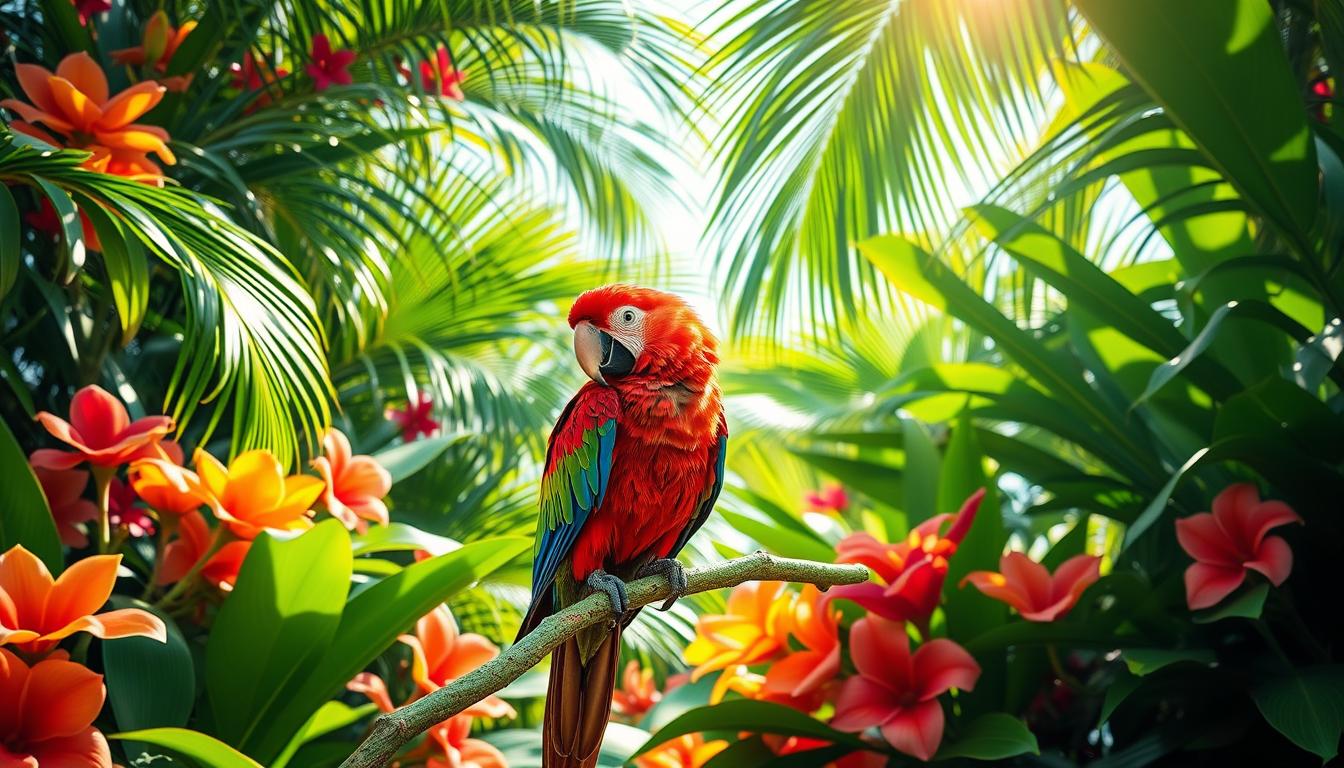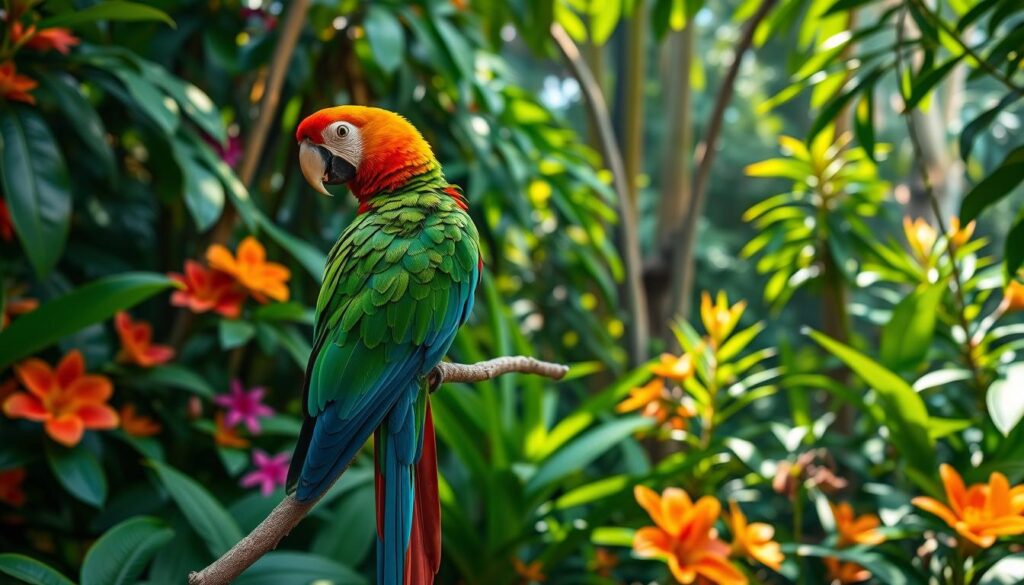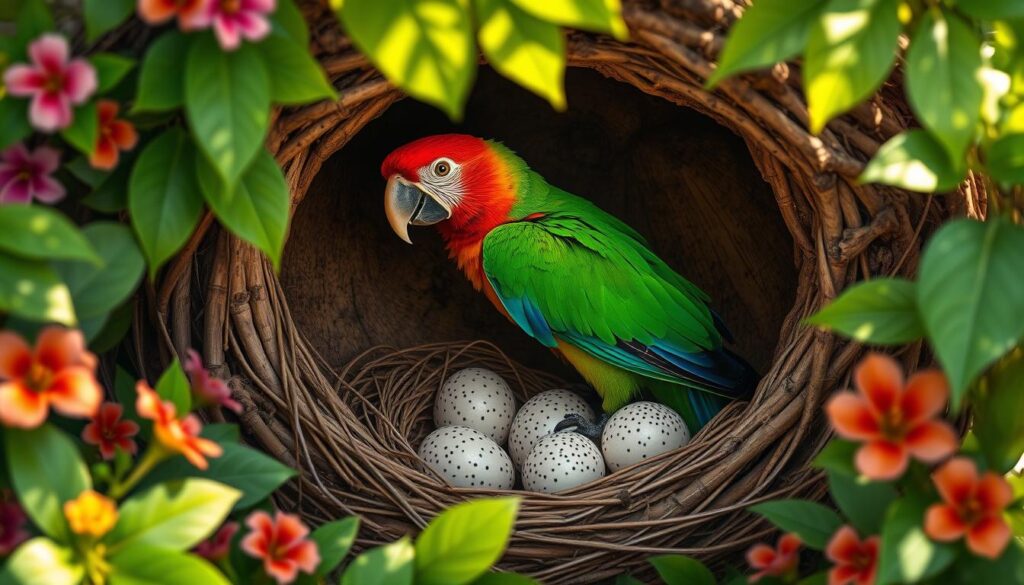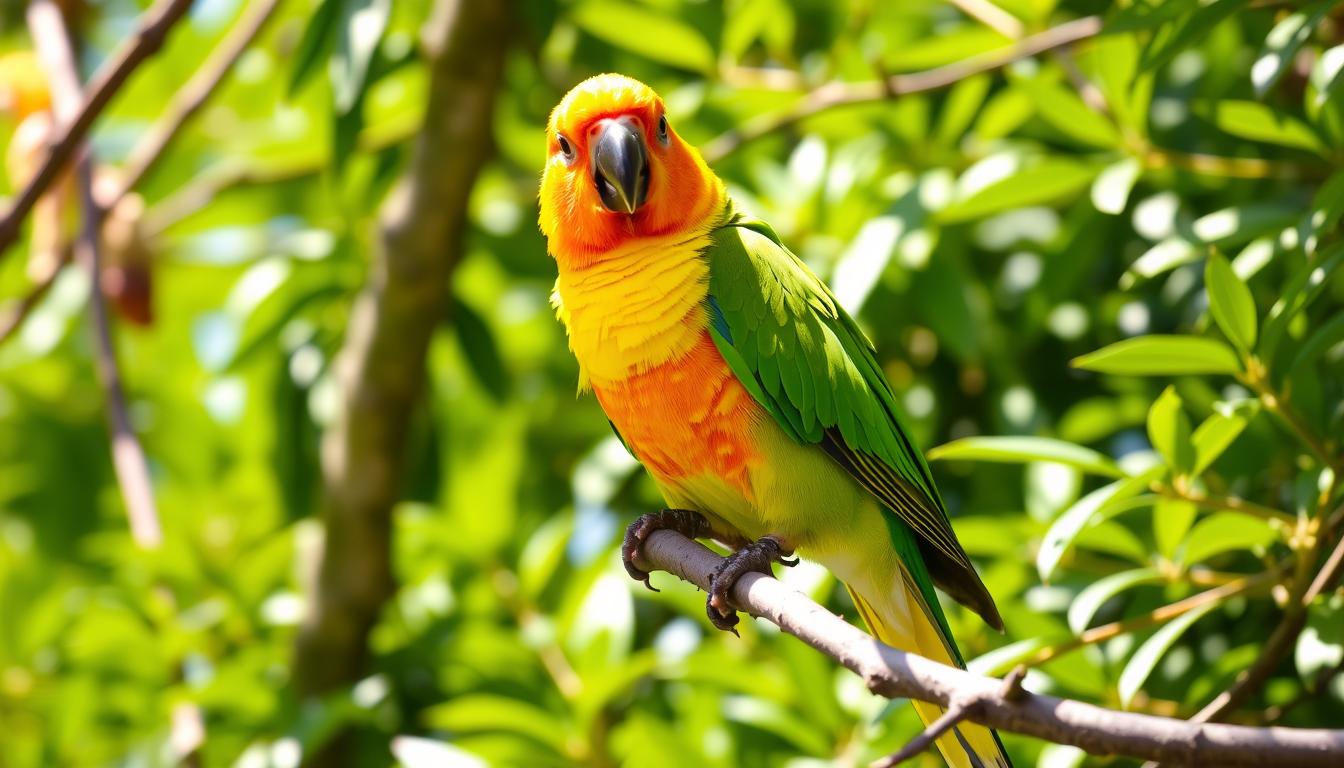Mexican Red Head Parrot: Colorful Feathered Friend

Many people admire the beauty of colorful exotic birds. But few know the Mexican Red Head Parrot, also known as the red headed Amazon, is more than just a pretty sight. It’s a lively member of bird lovers’ communities around the world. As an endangered species, it’s vital to learn about their care and habitat.
Thinking of getting a Mexican Red Head Parrot? They are about 11 to 13 inches long, with a wingspan of 15 to 16 inches, and weigh around 270 grams1. They show the variety in the world of bird companions. With the right care, your bond with this bird can grow strong.
If you love exotic pets, there’s more to explore. Minks, for example, have their own needs and can bring joy to the right owner. For more on minks and other exotic pets, check out PetPawza. It’s a great place for deep pet insights.
Key Takeaways
- Red headed Amazons are popular pets for their beauty, long-term friendship, and endangered status. This makes them a big responsibility for owners.
- Knowing the Mexican Red Head Parrot’s habitat, diet, and behavior is key to their happiness as pets.
- Dealing with colorful exotic birds means understanding their specific needs well.
- It’s important to protect the red headed Amazon. Owners must help keep their natural numbers up.
- Bird lovers also find fascination in other exotic animals, like minks, which interest passionate animal fans.
Introduction to the Mexican Red Head Parrot
Welcome to the world of the Mexican Red Head Parrot, also known as the red headed amazon. This parrot is a sight to behold and is crucial for conservation. Found in northeast Mexico, it’s loved by bird lovers in the U.S., especially in southern Texas, Florida, and California2.
The Mexican Red Head Parrot can live up to 80 years and grows to 11-13 inches tall. It’s a big bird with a wingspan of 15-16 inches, making it a great pet for those who can care for it3.
Their home is facing big challenges; over 80% of their native plants are gone. This puts their future at risk4. But, these parrots are adaptable and can even live in cities like Los Angeles and Miami2.
These parrots are protected by CITES Appendix I and are considered endangered. They eat a variety of foods like acorns and pine seeds, depending on the season4.
Conservation Status and Actions: The Mexican Red Head Parrot is a top conservation priority. It has a score of 20 out of 20 by Partners in Flight, showing it’s very important to save4. Poaching and habitat loss are big threats, so we need to act fast4.
Whether you love watching birds or want a parrot as a pet, knowing about the Mexican Red Head Parrot is key. Their bright colors, fun behaviors, and sounds make them special. Saving them is important for both birds and humans.
The Distinctive Appearance of the Red Headed Amazon
The red crowned amazon is famous for its stunning looks and behavior. It’s a top choice among bird lovers. Their bright colors are amazing whether they’re in the wild or in a home.
Bright Red Crown: Signature Mark of Beauty
The red crowned amazon, or Mexican red-headed parrot, has a bright red crown. It looks like royal headwear. Their cheeks are also red, making them even more charming.
Studies show their feathers rarely change, keeping their beauty consistent. This makes them a favorite among bird watchers5.
Lush Green Plumage with Color Accents
Their green feathers are the perfect base for other colors. They have a blue stripe behind their eyes and a white ring around them. This highlights their bright eye colors, which can be yellow or red.
Under their wings, colors change from green to blue and red, with yellow tips on their tails. This mix of colors makes them stand out in the wild and in homes5.
Amazon parrots, like the red crowned amazon, often have green feathers with different colors. This variety makes them special6.
Efforts to save these birds are ongoing. Knowing their colors helps us protect and study them. Places like Preuss’s Pets teach us about their care and behavior. This helps us connect with these amazing birds.
Understanding the Habitat Requirements of Colorful Parrot Species
The Mexican red headed parrot is a stunning bird that can live in many places. They originally came from Mexico’s northeast. Now, they can be found in different environments, like forests and cities, thanks to their adaptability.
But, their homes in the wild are getting harder to find. Sadly, their numbers have dropped by 95%7. This forces them to live in places they’re not meant to be.
It’s important to keep their natural homes safe. By doing so, we help these birds stay bright and lively. In places like Texas’s Lower Rio Grande Valley, where about 700 birds live7, saving their homes is crucial.
Here’s a look at why different habitats are key for these birds:
| Species | Population | Location | Conservation Status |
|---|---|---|---|
| Mexican Red headed Parrot | 4,700 (U.S.)7 | U.S., Mexico | Endangered7 |
| Amazon Parrots | 31 species8 | Global | Varies |
| Cockatoos | 21 species8 | Australia, New Guinea | Varies |
These birds need more than just space. They need a place that feels like home. This helps them survive and can even help local businesses through bird watching tours7.
Learning about the needs of birds like the Mexican red headed parrot is an ongoing task. We need to keep talking about it, doing research, and working together. This way, these colorful birds can keep flying and living with us.
Insights into the Behavior Characteristics of the Mexican Red Head Parrot
When we look at the Mexican red head parrot’s behavior, we see their world and how they interact. This knowledge helps us care for them better if we want to have one as a pet.
Social Dynamics in the Wild
The Mexican red head parrot lives in a complex social world. They often gather in big groups, showing how much they like to be together. They even share food and sleep spots, showing their strong social bonds.
These birds live near rivers and in mangrove forests. They fit right into their environment9.
They mostly talk to each other with sounds. They can learn many words and sounds, helping them warn others or find food. This shows how smart they are at communicating9.
Companion Behavior in Domestic Settings
When they live with people, they become very attached. They love to be around their owners and enjoy doing things together. This makes their bond with humans very strong.
They need to be around people a lot, just like they are in the wild. Using good pet care tips helps keep them happy and healthy. This stops problems like being too fat or not getting enough vitamin A9.
Knowing how they behave makes caring for them better. It also makes sure they are happy and healthy. This makes them great pets for a long time.
Exotic Bird Profile: Diet and Nutrition Essentials
When caring for a Mexican Red Head Parrot, knowing their diet is key. These birds love a mix of seeds, grains, nuts, and fruits. Adding flowers and nectar can also be good. But, it’s important to avoid bad diets that can harm them10.
For your parrot’s health, give them a balanced commercial bird food. This food should match their age, activity level, and health needs. Today, there are special foods made just for them10.
| Consideration | Essential Nutrients | Common Deficiencies |
|---|---|---|
| Diet Composition | Calcium, Iodine, Selenium, Vitamins A, E, and D | Calcium, Vitamin A |
| Hydration | Fresh water always available | Dehydration risks |
| Behavioral Enrichment | Branches, varied diet | Boredom, behavioral issues |
When it comes to supplements and diet for Mexican Red Head Parrots, be careful. Too much of a good thing can be bad. Homemade diets need to be balanced well to avoid health problems10.
It’s interesting to note that grit and salt licks are not needed for these birds. Instead, offer a variety of foods to keep them healthy and happy10.
If your parrot eats differently or seems sick, see a vet. They can check for any diet problems10. For more on parrot care, check out Harrison’s Bird Foods. They’re experts in keeping birds healthy.
Following these tips will keep your Mexican Red Head Parrot happy and colorful for a long time.
Exploring Bird Watching Enthusiasts’ Engagement with the Red Headed Amazon

Bird watching fans love the red headed Amazon for its bright colors and fun behavior. Seeing these parrots in the wild helps us learn more about birds. They can be found in many places, making bird watching exciting everywhere11.
These birds can live up to 60 years, keeping bird watchers and scientists interested. They are big, ranging from 11 to 20 inches, making them easy to spot11.
Learning about their diet and behavior makes bird watching more than just watching. The red headed Amazon eats seeds, berries, nuts, and fruits. This shows why we need to protect their homes11.
| Behavior Aspect | Observation in Natural Habitat | Importance to Bird Watchers |
|---|---|---|
| Feeding | Consumption of a varied diet including seeds and fruits | Provides insights into food preferences and natural diet |
| Social Interaction | Frequent vocalizations and flock coordination | Enhances understanding of social structures and communication |
| Adaptability | Ability to thrive in diverse environmental settings | Indicates robustness and environmental impact on bird species |
Their loud calls and social behavior make them even more interesting12. They use their beaks to move through leaves, showing their cleverness12.
“Engagement with such unique bird species not only enlightens us about avian life but fosters a greater appreciation for nature’s intricacies,” observers note.
By watching birds, you help research and protect species like the red headed Amazon. Your efforts are key to saving these birds and their homes. Whether you’re recording sightings or just enjoying their beauty, you play a big role in bird conservation.
Captive Care: Essential Pet Care Tips for the Mexican Red Head Parrot
Keeping your Mexican red head parrot healthy and happy is key. As a parrot owner, knowing and using advanced pet care tips is important. It makes life better for both you and your exotic bird.
Creative Enrichment for Mental and Physical Well-being
Enrichment activities are vital for your Mexican red head parrot’s mind and body. These smart birds need more than basic care. They need fun and challenging environments to keep their minds and bodies sharp.
Use a variety of toys, puzzle feeders, and training exercises. This helps prevent health problems like obesity and stress. These issues are common in birds without enough stimulation13.
Make their living space exciting. Use different size and material perches to encourage movement. Add toys that challenge their problem-solving skills. Foraging for food can also be natural and beneficial for their well-being13.
It’s also important to think about their diet. Feed them a balanced mix of pellets, fruits, and vegetables. This helps prevent obesity and ensures they get the nutrients they need13. Avoid giving too many treats, especially sunflower and safflower seeds, to keep them healthy.
| Diet Component | Amount |
|---|---|
| Pellets | 1/4 cup daily |
| Fresh Fruits and Vegetables | 1/4 cup daily |
| Supplements (Calcium, Vitamins) | As recommended by vet |
Regular vet visits are crucial. These birds can live up to 50 years, so long-term care is important13. By staying on top of their health, you can avoid diseases and keep them thriving.
By understanding your Mexican red head parrot’s needs, you ensure a happy and rewarding relationship. The joy they bring is a result of the care and love you give them.
Conservation Efforts for the Endangered Red Headed Amazon
The endangered red headed amazon, also known as the red-crowned parrot, is a big concern for conservationists. It’s listed as endangered on the IUCN Red List. This means its future is at risk14. With only 625 in the lower Rio Grande Valley of Texas, action is urgent14.
Special efforts are underway to save this species. Monitoring surveys are happening in south Texas and northern Mexico. These surveys aim to guide effective conservation14. The American Bird Conservancy and others are working hard to protect these parrots’ homes in northern Mexico14.
The red-crowned parrot’s home has shrunk to 19.2% of its original size. This is due to habitat loss and the illegal pet trade15. In Mexico, its range has dropped by 77%, from 140,000 km² to 32,500 km²15.
In places like Brownsville, people are working to protect the parrot. They see it as part of their community. This shows the importance of saving the parrot, even in places it’s not native16.
The fight to save the red-crowned parrot is not just about this bird. It’s a symbol of the bigger fight to protect wildlife everywhere. Every step we take to help them is a step towards saving our planet’s biodiversity.
Mexican Red Head Parrot in Aviculture: Breeding and Nesting Facts

Exploring aviculture, we learn a lot about the Mexican Red Head Parrot’s breeding and nesting. This colorful bird is loved by many, showing strong loyalty in its mating habits.
Monogamous Nature and Breeding Cycles
The Mexican Red Head Parrot is known for being monogamous, staying with one partner for life. They start breeding between 3 to 5 years old. During this time, females lay 3 to 4 eggs on average17.
Incubation lasts about 24 to 26 days, mainly done by the female. The male helps by finding food for his mate. This teamwork shows how strong their bond is, helping them succeed in aviculture18.
Importance of Nest Site Fidelity
Nest site fidelity is key for the Mexican Red Head Parrot. They often use the same nesting site every year. These sites are tree cavities that are just right for laying eggs and raising chicks18.
These cavities need to be at least 5.5 cm wide and over 23 cm deep. This ensures the chicks have enough room and safety18. But, if they don’t succeed, they might choose a new spot the next year. This shows how important a safe and stable nest is for their success17.
By understanding these nesting habits, aviculturists can create better environments for these parrots. This helps in conservation efforts, as the species is vulnerable and its wild numbers are dropping17.
For those who own or breed Mexican Red Head Parrots, learning about aviculture is crucial. It helps you care for these birds better. By creating the best breeding conditions, you support the survival of this amazing species for years to come.
How to Create a Bird-Friendly Environment for Your Feathered Friend
Creating a bird-friendly environment is key for your Mexican Red Head Parrot’s health. A good habitat boosts their physical, mental, and emotional well-being. This includes the cage, perches, toys, and activities you offer.
Selecting the Right Cage and Perches
Choosing the right cage is crucial. Opt for a spacious cage made from American materials to avoid metal toxicity. It should also have enough room for your parrot to move around19.
Use natural branches and rope perches for foot exercise. This helps prevent health issues like infections19. A clean, secure cage with different perch sizes is great for your parrot’s health.
The Role of Toys and Activities in Avian Health
Interactive toys and puzzles are vital to keep your parrot engaged19. These activities keep their mind sharp and encourage natural behaviors. Daily activities are key for their physical and emotional health.
For more detailed pet care tips, visit comprehensive bird care plans. These guides help maintain a healthy, stimulating environment for your parrot.
| Diet Component | Percentage | Types of Foods |
|---|---|---|
| Whole Grains | 50% | Includes seeds as part of the diet. |
| Vegetables | 30-40% | Offers a variety of fresh vegetables daily. |
| Proteins | Varies | Cooked meats, nuts, and beans. |
Supplement your bird’s diet with fresh fruits and vegetables daily. Avoid avocados and limit dairy products. This balanced diet is essential for their health and longevity20.
Interactions and Training: Forming a Bond with Your Bird
Building a strong bond with your Mexican Red Head Parrot starts with consistent interactions and training. Every moment you spend together is a chance to grow closer. This is key for a happy and healthy relationship between you and your pet.
Teaching your Mexican Red Head Parrot is all about the right approach. Wrong handling can make them aggressive or unwilling to learn21. Start by being calm and confident. Parrots like it when you show them you’re in charge21.
Using positive methods in your training will make a big difference. Hold them gently but firmly, making sure they can breathe easily21. Also, training regularly helps them get used to you. This makes learning new things, like ‘step-up’, easier22.
Learning about your parrot’s hormones can help you avoid training problems. This way, you can adjust your teaching to fit their mood22.
Being consistent in how you interact with your parrot is very important21. Every positive training session builds trust. And with each new trick, your bond gets stronger22.
The bond you create with your Mexican Red Head Parrot through careful training and interaction is rewarding. It not only makes you happier but also improves your parrot’s life.
Conclusion: Celebrating the Beauty and Uniqueness of the Mexican Red Head Parrot
The Mexican Red Head Parrot is a standout in the world of exotic birds. Their bright colors grab the attention of bird lovers and casual viewers. Their green feathers and red crown make them a true marvel.
These parrots show the wild spirit, even in homes. They are smart and loving. Their beauty adds color to our world, beyond their natural habitats.
We must care for these birds responsibly. This ensures they continue to amaze us in the future. Every bird, like the Mexican Red Head Parrot, is vital to our planet. We must protect them and learn how to care for them well.
Our actions help these birds thrive. By supporting conservation and creating bird-friendly spaces, we help them soar. These parrots show the beauty of our planet and the bond between humans and wildlife.
It’s our duty to keep the Mexican Red Head Parrot a symbol of wonder. Through education and action, we can make sure they continue to inspire us.



